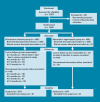The Fremantle Primary Prevention Study: a multicentre randomised trial of absolute cardiovascular risk reduction
- PMID: 22520669
- PMCID: PMC3252536
- DOI: 10.3399/bjgp12X616337
The Fremantle Primary Prevention Study: a multicentre randomised trial of absolute cardiovascular risk reduction
Abstract
Background: Cardiovascular disease (CVD) is the leading cause of global mortality. Risk factor management in clinical practice often relies on relative risk modification rather than the more appropriate absolute risk assessment.
Aim: To determine whether patients receiving more-frequently designated GP visits had increased benefit in terms of their absolute CVD risk assessment, as compared with patients in receipt of their usual GP care.
Design and setting: Prospective, open, pragmatic block randomised study in a 1:1 group allocation ratio in three Western Australian general practices.
Method: A convenience sample (n = 1200) of patients aged 40-80 years were randomised to 3-monthly GP visits (five in total for the intensive) or usual GP care (two in total for the opportunistic), with 12 months' follow-up. The main outcome was absolute CVD risk scores based on the New Zealand Cardiovascular Risk Calculator. Others outcome measures were weight, height, waist circumference, blood pressure, and fasting blood lipids and glucose.
Results: There were 600 patients per group at baseline. At 12 months' analysis there were 543 in the intensive group and 569 in the opportunistic group. Mean (standard deviation [SD]) absolute CVD risk reduced significantly between baseline and 12 months in the intensive group (6.28% [5.11] to 6.10% [4.94]) but not in the opportunistic group (6.27% [5.10] to 6.24% [5.38]). There was a significant reduction between baseline and 12 months in mean (SD) total cholesterol (5.28 mmol/l [0.94] to 5.08 mmol/l [0.96]); low-density lipoprotein cholesterol (3.08 mmol/l [0.87] to 2.95 mmol/l [0.89]); triglyceride (1.45 mmol/l [0.86] to 1.36 mmol/l [0.84]); and in mean (SD) waist circumference in men (98.74 cm [10.70] to 97.13 cm [10.20]) and females (90.64 cm [14.62] to 88.96 cm [14.00]) in the intensive group.
Conclusion: A targeted approach using absolute risk calculators can be used in primary care to modify global CVD risk assessment.
Comment in
-
The Fremantle Primary Prevention Study: a multicentre randomised trial of absolute cardiovascular risk reduction.Br J Gen Pract. 2012 Apr;62(597):180; author reply 180-1. doi: 10.3399/bjgp12X635994. Br J Gen Pract. 2012. PMID: 22520895 Free PMC article. No abstract available.
References
-
- World Health Organization. Global health risks: mortality and burden of disease attributable to selected major risks. Geneva: WHO; 2009. http://www.who.int/healthinfo/global_burden_disease/GlobalHealthRisks_re... (accessed 29 Sep 2011)
-
- Access Economics. The shifting burden of cardiovascular disease in Australia. Report No 18. Canberra, Sydney, Melbourne: Access Economics; 2005. http://www.heartfoundation.org.au/SiteCollectionDocuments/HF-Shifting_bu... (accessed 29 Sep 2011)
-
- Proietto J, Baur LA. 10: Management of obesity. Med J Aust. 2004;180(9):474–480. - PubMed
-
- Australian Bureau of Statistics. Tobacco smoking in Australia: a snapshot, 2004–05. http://www.abs.gov.au/ausstats/abs@.nsf/mf/4831.0.55.001 (accessed 29 Sep 2011)
-
- Fraser GE, Shavlik DJ. Ten years of life: is it a matter of choice? Arch Intern Med. 2001;161(13):1645–1652. - PubMed
Publication types
MeSH terms
Substances
LinkOut - more resources
Full Text Sources

